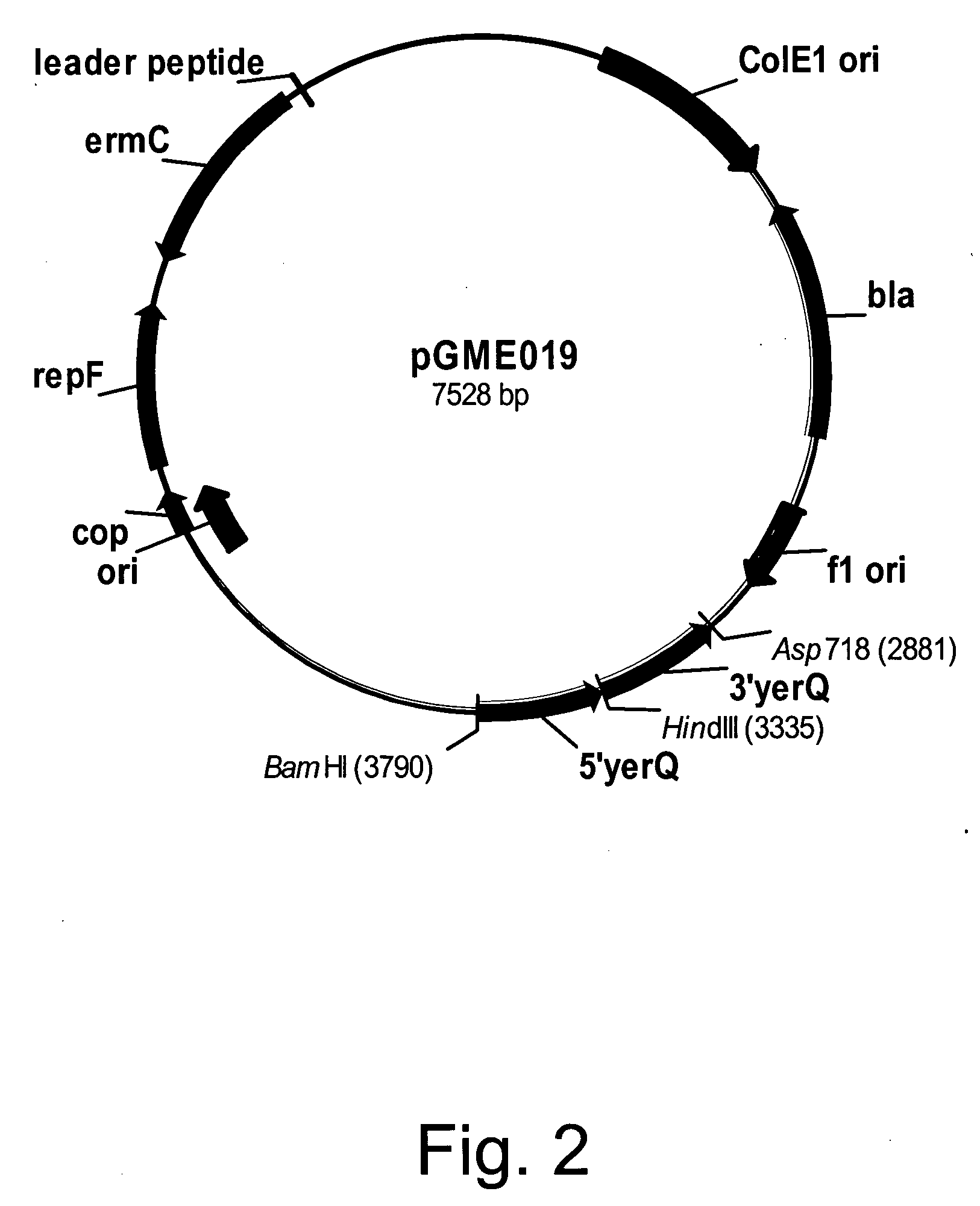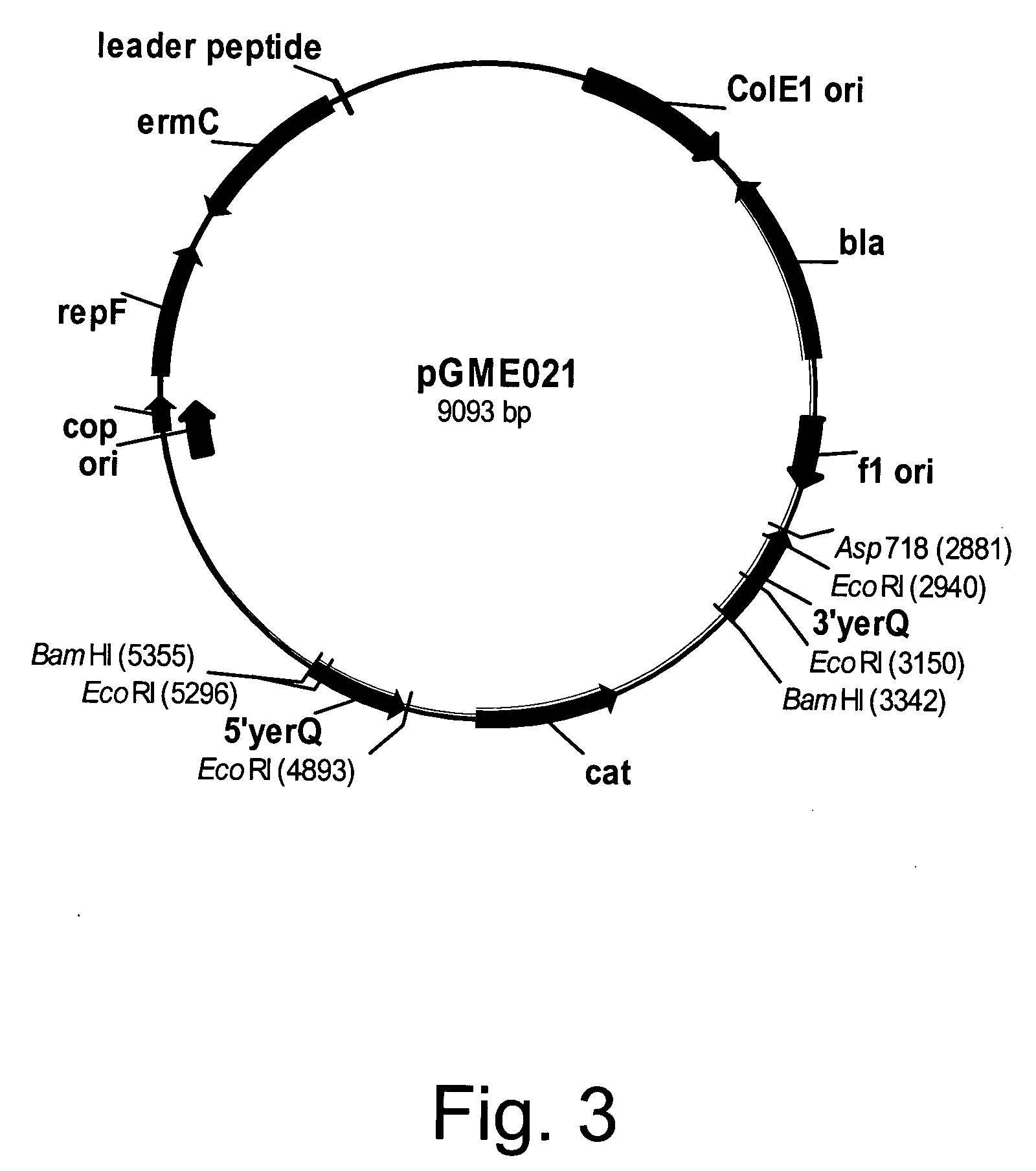Methods for identifying markers of antimicrobial compounds
a technology of antimicrobial compounds and markers, which is applied in the field of methods for identifying markers of antimicrobial compounds, can solve the problems of hampered discovery of new compounds for use as antimicrobial agents, affecting the public health of disease-causing microorganisms that have become resistant to antibiotic therapy, and increasing the number of health problems
- Summary
- Abstract
- Description
- Claims
- Application Information
AI Technical Summary
Benefits of technology
Problems solved by technology
Method used
Image
Examples
example 1
Microbroth Dilution Assays
[0191] Microbroth dilution assays were performed as described in NCCLS M7-A5 (Vol. 20, No. 2). The assay was performed in a sterile 96 well plate, and the total volume per well was 100 μl. The inoculum was prepared to give approximately 104 to 105 colony forming units per well and the compounds were tested at concentrations from 0.0625 to 256 μg / ml in two-fold step dilution. The inoculum was prepared by culturing Bacillus subtilis BGSC1A2 overnight in MHB medium at 35° C. with shaking at 200 rpm. The following day 0.5 ml of the overnight culture was used to inoculate MHB medium to obtain a culture in logarithmic phase growth as described in NCCLS M7-A5 (Vol. 20, No. 2) and M26-A (Vol. 19, No. 18). The actual colony forming units per well was confirmed by plating onto TSA or LB agar. Two wells were inoculated for a given concentration. The plates were incubated for 16 to 20 hours at 35° C. The MIC was defined as that concentration of antibiotic resulting in...
example 2
Treatment of Bacillus subtilis Cultures with Sub-Inhibitory Concentrations of Antibiotics
[0193]Bacillus subtilis strain BGSC1A2 was streaked onto a LB agar plate and incubated overnight at 37° C. The cultured plate was stored at room temperature for up to one week. Fifty ml of MHB medium in a 250 ml flask was inoculated with one colony from the plate. The culture was incubated overnight at 37° C. and 200 rpm.
[0194] A 30.7 ml sample of the overnight culture was used to inoculate 3.6 liters of MHB medium pre-warmed at 37° C. After mixing the culture well, 600 ml aliquots were removed and placed into each of six 2.8 liter baffled shake flasks. A 1 ml sample of each flask was taken for optical density measurement at 600 nm, and the shake flasks were incubated at 37° C. and 200 rpm. One ml samples were taken from each flask every 30 minutes until the OD600 reached 0.2. At this point, which was designated time zero, 100 ml samples from each shake flask were taken, and 50 ml aliquots wer...
example 3
Isolation of Total RNA from Shake Flasks Samples
[0198] The cell pellets from Example 2 were thawed on ice, and RNA was prepared using the FastRNA™ Blue Kit (BIO101) (QBIOgene, Carlsbad, Calif.), according to the manufacturer's instructions, with minor modifications. Two hundred microliters of cell suspension was added to each FastPrep™ blue tube containing the lysing matrix as well as the other required reagents as listed in the protocol. The total number of tubes per frozen sample was adjusted depending on the volume but was typically three to four FastPrep™ blue tubes per pellet. After addition of the cell suspension to the FastPrep™ blue tubes, the tubes were processed in the FastPrep™ instrument at a speed rating of 6, one time for 45 seconds, and placed on ice to cool prior to opening. The samples were centrifuged as per the protocol, and the top phase was collected and combined with replicate samples in a Falcon 2059 polypropylene tube. Appropriate volumes of reagents, as lis...
PUM
| Property | Measurement | Unit |
|---|---|---|
| diameters | aaaaa | aaaaa |
| diameters | aaaaa | aaaaa |
| diameters | aaaaa | aaaaa |
Abstract
Description
Claims
Application Information
 Login to View More
Login to View More - R&D
- Intellectual Property
- Life Sciences
- Materials
- Tech Scout
- Unparalleled Data Quality
- Higher Quality Content
- 60% Fewer Hallucinations
Browse by: Latest US Patents, China's latest patents, Technical Efficacy Thesaurus, Application Domain, Technology Topic, Popular Technical Reports.
© 2025 PatSnap. All rights reserved.Legal|Privacy policy|Modern Slavery Act Transparency Statement|Sitemap|About US| Contact US: help@patsnap.com



